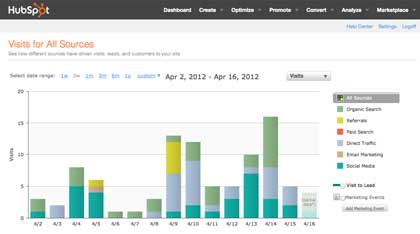How to Calculate Inbound Marketing Success
The pioneering ad man John Wanamaker once famously said “Half the money I spend on advertising is wasted. The trouble is I don't know which half.” Throughout the history of marketing, one of the biggest problems has always been drawing an actual correlation between ad dollars spent today and sales made tomorrow. However, in recent years, that's all changed thanks to the Internet and inbound marketing.
It's now quite possible to directly track the success of your inbound marketing ventures. In fact, in some ways, the problem has bounced over to the opposite extreme. It's now become easy to get buried in data and lose sight of which metrics actually indicate a successful inbound marketing campaign.
Not Seeing the Forest for the Leaves
For example, many people – and, sadly, many online marketing firms – still focus on statistics such as click-through rates, bounce times, page views, and site visits. This is all useful information to have, and it's great data for helping to optimize your marketing strategies, but these metrics are the means, and not the end. It really doesn't matter if your site visits are up 5000% thanks to that new viral video on YouTube, if no one's actually buying the product.
Similarly, sales stats are great, but that's really just harkening back to the old way of doing marketing. Yeah, if you launch a new round of emails to your leads and see a 10% sales spike over the next week, you can pat yourself on the back for a job well-done and call it a day... but you'd really be missing a lot of the big picture.
Wouldn't it be better to know why that 10% spike wasn't 20% instead? Or to know exactly how many of those leads converted? Or to know how many of those sales actually came from your emails, as opposed to your PPC ads and search results ranking?
The Power of Analytics
To really get the most out of inbound marketing – to see its full potential – you need closed-loop analytics, and you need to know how to use them. It's now possible to track every visitor to your site through every step, from search engine to (hopefully) sales cart. You can see how long they lingered on certain pages, and what “path” they took through your site. The trick is to put this into a database and start looking for patterns.

With some number crunching, for example, you can immediately spot which pages lead to sales and which don't. Then you can target the under-performing pages and work on changing them into money-makers. It's the same with your emails. You can track every email sent, matching that against visits from your leads. If you track the statistics for a few rounds, you can quickly work out which pitches are working and which aren't. You could even start micro-targeting your advertising to ever-smaller demographics, trying to get messages precisely to the people who want to hear them.
Power Software
These sort of analytics can be extremely difficult... unless you get a good software package. That's the key to true inbound marketing success. By investing in software such as Hubspot or Infusionsoft, which are built specifically to track and analyze this sort of data, you can take your marketing to a whole new level.
Sure, you can still do marketing the old-fashioned way, but the companies who are finding the most success with inbound marketing are those who have embraced software analytics to find the true ROI of their marketing. If you want to join them, you need to as well.
DeepSky Marketing is a company that provides business owners and managers with profitable marketing systems and verifiable return on investment (ROI). To schedule a brief no-cost consultation call 707 823-3888.MORE RECENT BLOGS
How to structure your all-important offer! (in 90 seconds)
Your offer is the entry point into the sales process. A good offer sets up success; a lackluster one doesn’t. Here are best practices: A good offer co...
Graphic Design: Setting Tone and Mood On Your Site
As the Internet continues to develop and evolve and show us new ways to market, we're continually finding new ways of "embedding" messages into our co...
AI is Changing Business. Are You Ready?
In a world where AI is surging, our innate human intuition is becoming more crucial than ever before. An AI class just for you Artificial Intelligence...
Create Content for the Three Initial Marketing Stages
Hey, here's a riddle for you: What is the single most important part of your business, which will always be beyond your control? The answer? Your cust...
Is It Time For a Website Redesign?
You'd have to be pretty satisfied with the performance of your website not to occasionally look at it and wonder if it's time to redesign it. After al...




